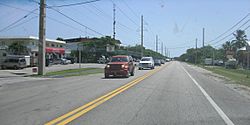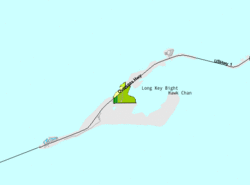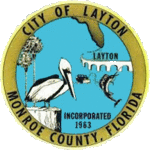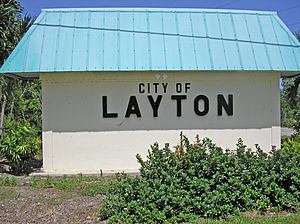Layton, Florida facts for kids
Quick facts for kids
Layton, Florida
|
||
|---|---|---|

Downtown Layton as seen from US 1 looking south along the road
|
||
|
||

Location in Monroe County and the state of Florida
|
||

U.S. Census Bureau map showing city limits
|
||
| Country | ||
| State | ||
| County | ||
| Settled (Long Key Settlement) | Late 1800s–1910 | |
| Incorporated (City of Layton) |
September 18, 1963 | |
| Government | ||
| • Type | Mayor-Council | |
| Area | ||
| • Total | 0.22 sq mi (0.58 km2) | |
| • Land | 0.16 sq mi (0.42 km2) | |
| • Water | 0.06 sq mi (0.16 km2) | |
| Elevation | 3 ft (0.9 m) | |
| Population
(2020)
|
||
| • Total | 210 | |
| • Density | 1,296.30/sq mi (499.47/km2) | |
| Time zone | UTC-5 (Eastern (EST)) | |
| • Summer (DST) | UTC-4 (EDT) | |
| ZIP code |
33001
|
|
| Area code(s) | 305 | |
| FIPS code | 12-39725 | |
| GNIS feature ID | 0285408 | |
Layton is a city located on the island of Long Key in Monroe County, Florida, United States. The city is part of the Florida Keys. The population was 210 at the 2020 census.
History
In the late 19th century, Long Key was used as a coconut plantation. By 1910, Layton was becoming famous as a fishing destination, thanks in part to promotion by sportswriter, Zane Grey. However, the developing tourist infrastructure on Long Key, including a station on the Overseas Railroad, was largely destroyed by the Labor Day Hurricane of 1935.
After World War II, Mary V. Layton (1907-1993) and Delbert “Del” Layton (1906-1987), who ran a grocery business in Miami, bought 40 acres (160,000 m2) on Long Key and started developing the property as "Layton's Long Key Fishing Camp", which grew substantially over the succeeding years.
The City of Layton was officially incorporated on September 18, 1963. The land that would become Long Key State Park was acquired between 1961 and 1973; the park opened on October 1, 1969.
Geography
The approximate coordinates for the City of Layton is located along U.S. Route 1 at 24°49′36″N 80°48′50″W / 24.826669°N 80.814006°W. Via US 1 it is 66 miles (106 km) northeast of Key West and 88 miles (142 km) southwest of Miami.
According to the United States Census Bureau, the city has a total area of 0.22 square miles (0.57 km2). 0.16 square miles (0.41 km2) of it are land and 0.06 square miles (0.16 km2) of it (27.03%) are water.
Climate
The City of Layton has a tropical climate, similar to the climate found in much of the Caribbean. It is part of the only region in the 48 contiguous states that falls under that category. More specifically, it generally has a tropical savanna climate (Köppen climate classification: Aw), bordering a tropical monsoon climate (Köppen climate classification: Am).
Demographics
| Historical population | |||
|---|---|---|---|
| Census | Pop. | %± | |
| 1970 | 100 | — | |
| 1980 | 88 | −12.0% | |
| 1990 | 183 | 108.0% | |
| 2000 | 186 | 1.6% | |
| 2010 | 184 | −1.1% | |
| 2020 | 210 | 14.1% | |
| U.S. Decennial Census | |||
2010 and 2020 census
| Race | Pop 2010 | Pop 2020 | % 2010 | % 2020 |
|---|---|---|---|---|
| White (NH) | 158 | 165 | 85.87% | 78.57% |
| Black or African American (NH) | 4 | 2 | 2.17% | 0.95% |
| Native American or Alaska Native (NH) | 3 | 0 | 1.63% | 0.00% |
| Asian (NH) | 4 | 0 | 2.17% | 0.00% |
| Pacific Islander or Native Hawaiian (NH) | 0 | 0 | 0.00% | 0.00% |
| Some other race (NH) | 0 | 0 | 0.00% | 0.00% |
| Two or more races/Multiracial (NH) | 2 | 2 | 1.09% | 0.95% |
| Hispanic or Latino (any race) | 13 | 41 | 7.07% | 19.52% |
| Total | 184 | 210 |
As of the 2020 United States census, there were 210 people, 55 households, and 28 families residing in the city.
As of the 2010 United States census, there were 184 people, 76 households, and 47 families residing in the city.
Languages
As of 2000, English as a first language accounted for 90.68%, while Spanish as a mother tongue made up 9.31% of the population.
Education
All public schools are served by the Monroe County School District. Students are zoned to Plantation Key School (K-8).
See also
 In Spanish: Layton (Florida) para niños
In Spanish: Layton (Florida) para niños



